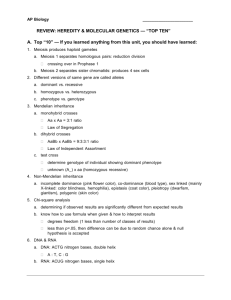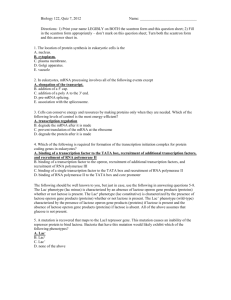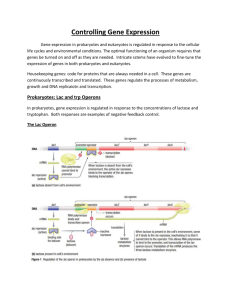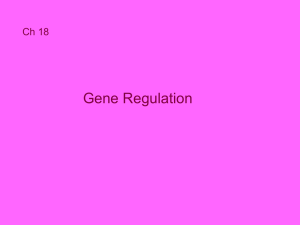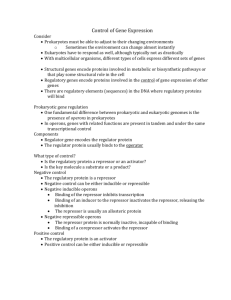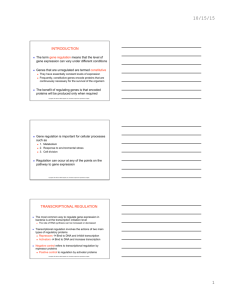CHAPTER 16
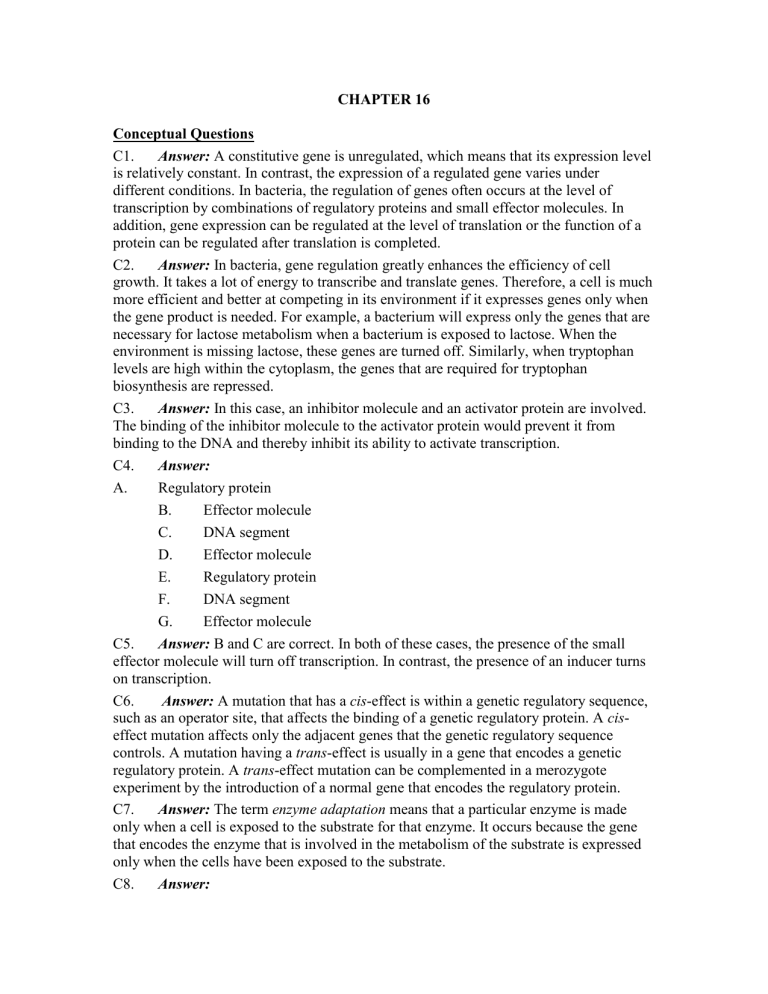
CHAPTER 16
Conceptual Questions
C1. Answer: A constitutive gene is unregulated, which means that its expression level is relatively constant. In contrast, the expression of a regulated gene varies under different conditions. In bacteria, the regulation of genes often occurs at the level of transcription by combinations of regulatory proteins and small effector molecules. In addition, gene expression can be regulated at the level of translation or the function of a protein can be regulated after translation is completed.
C2. Answer: In bacteria, gene regulation greatly enhances the efficiency of cell growth. It takes a lot of energy to transcribe and translate genes. Therefore, a cell is much more efficient and better at competing in its environment if it expresses genes only when the gene product is needed. For example, a bacterium will express only the genes that are necessary for lactose metabolism when a bacterium is exposed to lactose. When the environment is missing lactose, these genes are turned off. Similarly, when tryptophan levels are high within the cytoplasm, the genes that are required for tryptophan biosynthesis are repressed.
C3. Answer: In this case, an inhibitor molecule and an activator protein are involved.
The binding of the inhibitor molecule to the activator protein would prevent it from binding to the DNA and thereby inhibit its ability to activate transcription.
C4. Answer:
A. Regulatory protein
B.
C.
D.
Effector molecule
DNA segment
Effector molecule
E. Regulatory protein
F. DNA segment
G. Effector molecule
C5. Answer: B and C are correct. In both of these cases, the presence of the small effector molecule will turn off transcription. In contrast, the presence of an inducer turns on transcription.
C6. Answer: A mutation that has a cis -effect is within a genetic regulatory sequence, such as an operator site, that affects the binding of a genetic regulatory protein. A cis effect mutation affects only the adjacent genes that the genetic regulatory sequence controls. A mutation having a trans -effect is usually in a gene that encodes a genetic regulatory protein. A trans -effect mutation can be complemented in a merozygote experiment by the introduction of a normal gene that encodes the regulatory protein.
C7. Answer: The term enzyme adaptation means that a particular enzyme is made only when a cell is exposed to the substrate for that enzyme. It occurs because the gene that encodes the enzyme that is involved in the metabolism of the substrate is expressed only when the cells have been exposed to the substrate.
C8. Answer:
A. No transcription would take place. The lac operon could not be expressed.
B. No regulation would take place. The operon would be continuously turned on.
C. The rest of the operon would function normally but none of the transacetylase would be made.
C9. Answer: It would be impossible to turn the lac operon on even in the presence of lactose because the repressor protein would remain bound to the operator site.
C10. Answer: Diauxic growth refers to the phenomenon in which a cell first uses up one type of sugar (such as glucose) before it begins to metabolize a second sugar (such as lactose). In this case, it is caused by gene regulation. When a bacterial cell is exposed to both sugars, the uptake of glucose causes the cAMP levels in the cell to fall. When this occurs, the catabolite activator protein (CAP) is removed from the lac operon so it is not able to be activated by CAP.
C11. Answer:
A. Cis -effect. It would affect only the genes that are in the adjacent operon.
B. Trans -effect. This is a mutation that affects a protein that can move throughout the cell.
C. Trans -effect. This is a mutation that affects a protein that can move throughout the cell.
D. Cis -effect. It would affect only the genes that are in the adjacent operon.
C12. Answer: A mutation that prevented the lac repressor from binding to the operator would make the lac operon constitutive only in the absence of glucose. However, this mutation would not be entirely constitutive because transcription would be inhibited in the presence of glucose. The disadvantage of constitutive expression of the lac operon is that the bacterial cell would waste a lot of energy transcribing the genes and translating the mRNA when lactose was not present.
C13. Answer: Attenuation means that transcription is ended before it has reached the end of an operon. Because it causes an end to transcription, it is a form of transcriptional regulation even though the translation of the trpL region plays a key role in the attenuation mechanism.
C14. Answer:
A. Attenuation will not occur because loop 2–3 will form.
B. Attenuation will occur because 2–3 cannot form, so 3–4 will form.
C. Attenuation will not occur because 3–4 cannot form.
D. Attenuation will not occur because 3–4 cannot form.
C15. Answer: A defective tryptophanyl-tRNA synthetase would make attenuation less likely. This is because the bacterial cell would have a lower amount of charged tRNATrp.
Therefore, it would be more likely for the ribosome to stall at the tryptophan codons found within the trpL gene, even if the concentration of tryptophan amino acids in the cell was high. When the ribosome stalls at these tryptophan codons, this prevents attenuation.
C16. Answer: The addition of Gs and Cs into the U-rich sequence would prevent attenuation. The U-rich sequence promotes the dissociation of the mRNA from the DNA, when the terminator stem-loop forms. This causes RNA polymerase to dissociate from the DNA and thereby causes transcriptional termination. The UGGUUGUC sequence would probably not dissociate because of the Gs and Cs. Remember that GC base pairs have three hydrogen bonds and are more stable than AU base pairs, which have only two hydrogen bonds.
C17. Answer: If you look very carefully at the RNA sequence in Figure 16.12, you will notice that a UAA codon is found just past region 2. Therefore, in this mutant strain, the
UGA stop codon at the end of region 1 could be read by the mutant tRNAGly and then the ribosome would stop at the UAA codon just past region 2. If the ribosome paused here, it would probably cover up a portion of region 3, and therefore the terminator 3–4 stem-loop would not form. According to this scenario, attenuation could not occur.
However, we should also keep in mind the issue of timing. The ribosome would have to be really close to RNA polymerase to prevent attenuation in this nonsense suppressor strain. It is possible that the 3–4 stem-loop might form before the ribosome reaches the
UAA stop codon just past region 2. Therefore, attenuation might occur anyway because the 3–4 stem-loop might form before the ribosome reaches the UAA stop codon.
C18. Answer: It takes a lot of cellular energy to translate mRNA into a protein. A cell wastes less energy if it prevents the initiation of translation rather than a later stage such as elongation or termination.
C19. Answer: Antisense RNA is RNA that is complementary to a functional RNA such as mRNA. The binding of antisense RNA to mRNA inhibits translation.
C20. Answer: One mechanism is that histidine could act as corepressor that shuts down the transcription of the histidine synthetase gene. A second mechanism would be that histidine could act as an inhibitor via feedback inhibition. A third possibility is that histidine inhibits the ability of the mRNA encoding histidine synthetase to be translated.
Perhaps it induces a gene that encodes an antisense RNA. If the amount of histidine synthetase protein was identical in the presence and absence of extracellular histidine, a feedback inhibition mechanism is favored, because this affects only the activity of the histidine synthetase enzyme, not the amount of the enzyme. The other two mechanisms would diminish the amount of this protein.
C21. Answer:
1. lac operon: The binding of allolactose causes a conformational change in the repressor protein and removes it from the operator site.
2. ara operon: The binding of arabinose to AraC breaks the looping interaction and leads to the activation of the ara operon.
3. trp operon: The binding of tryptophan to the trp repressor causes it to bind to the operator site and inhibits transcription.
C22. Answer: The two proteins are similar in that both bind to a segment of DNA and repress transcription. They are different in three ways. (1) They recognize different effector molecules (i.e., the lac repressor recognizes allolactose, and the trp repressor recognizes tryptophan. (2) Allolactose causes the lac repressor to release from the operator, while tryptophan causes the trp repressor to bind to its operator. (3) The
sequences of the operator sites that these two proteins recognize are different from each other. Otherwise, the lac repressor could bind to the trp operator, and the trp repressor could bind to the lac operator.
C23. Answer:
A. Antisense RNA or a translational repressor would shut down protein synthesis the fastest. A transcriptional repressor would also shut down the synthesis of mRNA, so it would eventually shut down protein synthesis once all of the preexisting mRNA had been degraded. Feedback inhibition would have no effect on protein synthesis.
B. Only a transcriptional repressor protein would shut down the synthesis of mRNA.
C. Feedback inhibition is the fastest way to shut down the function of a protein.
Antisense RNA and transcriptional repressors eventually prevent protein function once all of the preexisting mRNA and protein have been degraded.
